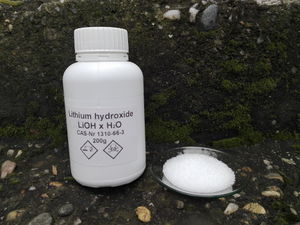Lithium hydroxide
 |
This article is a stub. Please help Sciencemadness Wiki by expanding it, adding pictures, and improving existing text.
|
 Lithium hydroxide sample and original bottle.
| |
| Names | |
|---|---|
| IUPAC name
Lithium hydroxide
| |
| Other names
Lithine
| |
| Properties | |
| LiOH | |
| Molar mass | 23.95 g/mol (anhydrous) 41.96 g/mol (monohydrate) |
| Appearance | White hygroscopic solid |
| Odor | Odorless |
| Density | 1.46 g/cm3 (anhydrous) 1.51 g/cm3 (monohydrate) |
| Melting point | 462 °C (864 °F; 735 K) |
| Boiling point | 924 °C (1,695 °F; 1,197 K) (decomposition) |
| anhydrous: 12.7 g/100 ml (0 °C) 12.8 g/100 ml (20 °C) 17.5 g/100 ml (100 °C) monohydrate: 2.3 g/100 ml (10 °C) 26.8 g/100 ml (80 °C) | |
| Solubility | Soluble in methanol Slightly soluble in ethanol |
| Solubility in methanol | anhydrous: 9.76 g/100 g (20 °C) monohydrate: 13.69 g/100 g (20 °C) |
| Solubility in ethanol | anhydrous: 2.36 g/100 g (20 °C) monohydrate: 2.18 g/100 g (20 °C) |
| Solubility in isopropanol | anhydrous: 0 g/100 g (20 °C) monohydrate: 0.11 g/100 g (20 °C) |
| Vapor pressure | ~0 mmHg |
| Thermochemistry | |
| Std enthalpy of
formation (ΔfH |
-20.36 kJ/g |
| Hazards | |
| Safety data sheet | Sigma-Aldrich (monohydrate) |
| Lethal dose or concentration (LD, LC): | |
| LD50 (Median dose)
|
210 mg/kg (oral, rat) |
| Related compounds | |
| Related compounds
|
Sodium hydroxide Potassium hydroxide Rubidium hydroxide Caesium hydroxide |
| Except where otherwise noted, data are given for materials in their standard state (at 25 °C [77 °F], 100 kPa). | |
| Infobox references | |
Lithium hydroxide is a solid white inorganic compound, with the chemical formula LiOH.
Contents
Properties
Chemical
Lithium hydroxide is corrosive and will slowly attack glass in aqueous solution. It will react with carbon dioxide from air to form lithium carbonate.
- 2 LiOH + CO2 → Li2CO3 + H2O
Because of its low density and it's ability to absorb it's weight of carbon dioxide, anhydrous lithium hydroxide is used as a chemical scrubber on submarines and space vehicles.
Physical
Lithium hydroxide is a a white hygroscopic solid. It is the weakest base among alkali metal hydroxides, however, it is still a strong base. The density of anhydrous lithium hydroxide is 1.46 g/cm3 and 1.51 g/cm3 for the monohydrate form. It is soluble in water and slightly less in ethanol. Lithium hydroxide melts at 462 °C and decomposes at 924 °C.
Availability
Lithium hydroxide is sold by chemical suppliers.
Corroded lithium batteries contain a mixture of lithium oxide, lithium hydroxide and lithium carbonate. Adding a solution of calcium hydroxide will convert the carbonate to hydroxide. Filter the suspension to remove the calcium carbonate then gently heat the filtrate solution to remove excess water.
Preparation
Lithium hydroxide can be prepared by mixing two solutions of lithium carbonate and calcium hydroxide.
- Li2CO3 + Ca(OH)2 → 2 LiOH + CaCO3
Lithium oxide will slowly convert to lithium hydroxide in moist air.
- 2 Li2O + 2 H2O → 2 LiOH
The presence of carbon dioxide in moist air will result in lithium carbonate.
Another way is to simply add lithium metal extracted from lithium batteries in water.
- 2 Li + 2 H2O → 2 LiOH + H2
However this method consumes the expensive metal.
Projects
- Make lithium chloride
- Make lithium salts
Handling
Safety
Lithium hydroxide is corrosive to all tissues and it must be handled with proper protection for alkali hydroxides.
Storage
In closed thick PE bottles, away from air, corrosive vapors and moisture.
Disposal
Best to try to recycle it.